Birding Tools of the 21st Century
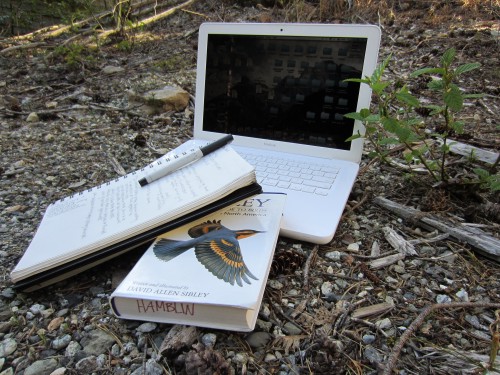
As students in the Masters of Environmental Education program, naturalizing is at the forefront of our studies. Our curriculum encourages, and requires, us to get outside and document our experiences in nature. We keep journals marked with sketches, notes and questions that record our findings and observations as we explore the North Cascades landscape.
As the spring months of April and May have greeted us, so have the birds. Our winged residents have returned to the North Cascades and many of us have been eagerly watching. A major perk of living in North Cascades National Park for a year is the opportunity to live deep in the mountain landscape under Colonial and Pyramid peaks, and keep close watch of the changing seasons throughout our year-long residency in this place.
With my home at the North Cascades Environmental Learning Center in close proximity to the forest, I have found myself in the midst of an ironic naturalist’s moment with birds. For several months, I have closely observed web cams zoomed in on an eagle’s nest located in Iowa, and another located on Hornby Island near Vancouver Island. While immersed in close observations of the intimate lives of eagle parents feeding and caring for their chicks, I noticed a red-breasted sapsucker prospecting a lodgepole pine right out my back door.
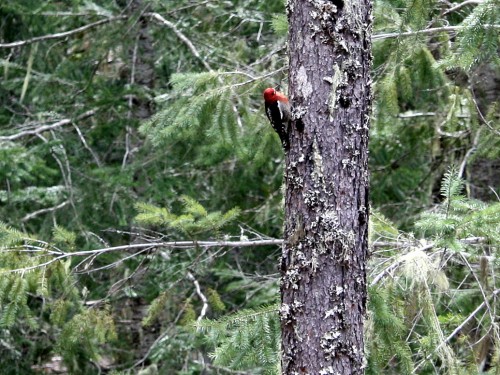
A red-breasted sapsucker surveys a lodgepole pine tree as a potential food source.
Assuming this bird would only be here for a moment, I stepped away from the web cams on the computer screen to watch the sapsucker examine the feeding possibilities of the tree. The sapsucker left and I resumed to my homework and web cam observations. A moment later, the small black, red and white bird returned, scooting up and down the trunk, peeling and tapping at the tree trunk. The sapsucker eventually flew away, only to return and stay for the next several weeks.
The sapsucker was serious in its pursuits, prying, probing and seeking food opportunities in this neighboring lodgepole pine. I grabbed my nature journal and quickly jotted observations and questions that came to mind while observing the sapsucker hard at work: times it left and returned to the tree, where and how it searched for food. Because the sapsucker sought food from the lodgepole pine by my house, I was able to watch the woodpecker more closely than normal. Binoculars were not necessary for these observations, as I watched the bird transform a section of the tree from uniform bark to chipped-out siding covered in bullet-like holes.
Remnants of the sapsucker’s methodical excavating process in search of a food supply. The species’ diet consists primarily of sap and insects.
For several weeks while completing computer work, I bounced between observations of the sapsucker and its most recent impacts on the lodgepole pine, and the eagle parents tending to their chicks. A journal, pencil, binoculars and guidebook have traditionally been my naturalizing staples. I never considered the benefits of web cams. But because of this technology, myself and others have been able to experience such close, real-time observations from the eagle’s nests that we would not otherwise have been able to see.
I have enjoyed watching the young start as eggs and emerge as small chicks. In one nest these chicks have grown into much larger youngsters. I have also observed the behavior among nest residents throughout various times of day (one of the cams has night vision). One of my favorite things to watch is parents feeding their chicks dead fish, small mammals and birds, and see how the young compete for their food. I’ve also gotten a better idea of what the the actual grassy nest looks like inside the massive stick-frame structures we often see here in the Northwest.
By watching the web cams I have learned more about the nesting habits of eagles that can be applied to the species that reside here in the North Cascades and Skagit Valley year round. Although web cams provide unique opportunities to watch and learn about this amazing place and its inhabitants, I still value the significance of stepping away from our computers and gadgets and going outside to make our own amazing discoveries. Unfortunately, web cams can only present viewers with the image directly before the camera, and people can potentially miss out on significant information pertaining to the nesting habits of the birds that one could see if they were there in person. But then again, it’s unlikely we can have the opportunity to get that close to an occupied eagle’s nest to see what’s happening inside.
Red-breasted sapsucker explores potential feeding opportunities on the deck railing on staff housing at the Learning Center. Woodpeckers can be heard knocking on metal pieces of housing and nearby electrical poles.
Many learning opportunities were had as the sapsucker pursued a food source on a nearby lodgepole pine.
I’m still following the two eagle web cams from time to time while completing homework on the computer, but the sapsucker eventually abandoned the lodgepole behind the house. My observations of the sapsucker taught me to recognize their call echoing in the forest and their signs are apparent on other trees at the Learning Center.
Another naturalist discovery has recently been made here at the Learning Center. Two days ago, with spotting scope in hand, a colleague in my graduate cohort showed me a falcon pair nesting on a cliff face near Diablo Dam. Although we don’t have the close-up view of the 24-7 web cam, we do have a big-picture perspective of the birds’ environment and the thrill of making our own personal discoveries of the nest residents as we follow their progress this spring.We’ll most likely make more big-picture naturalist discoveries in the process than if we were at a computer.
Throughout these observations I have found the value of Internet naturalizing as it offered unique opportunities to learn more about eagles. But the sapsucker, and now more recently the falcons, have convinced me that the most inspiring form of naturalizing involves time outside with binoculars, nature journal and guide book in hand. It’s where the best discoveries are made.


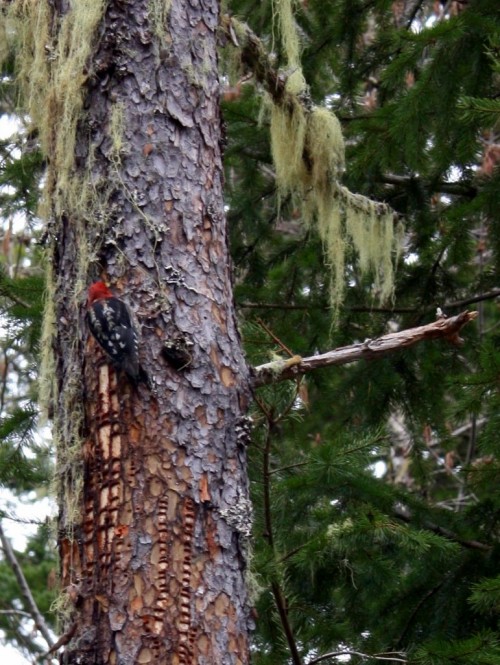
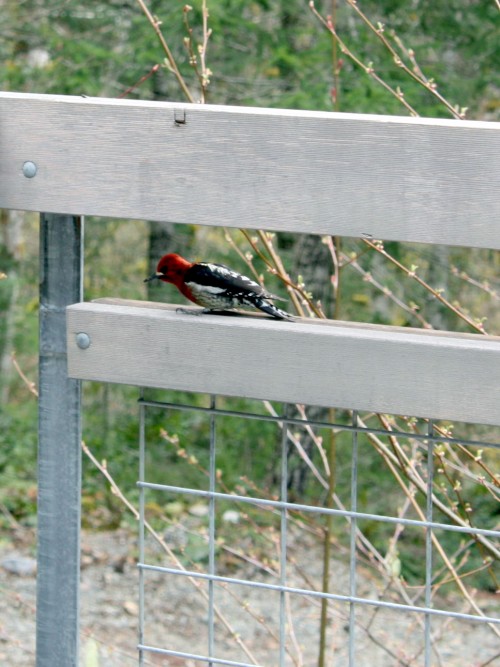
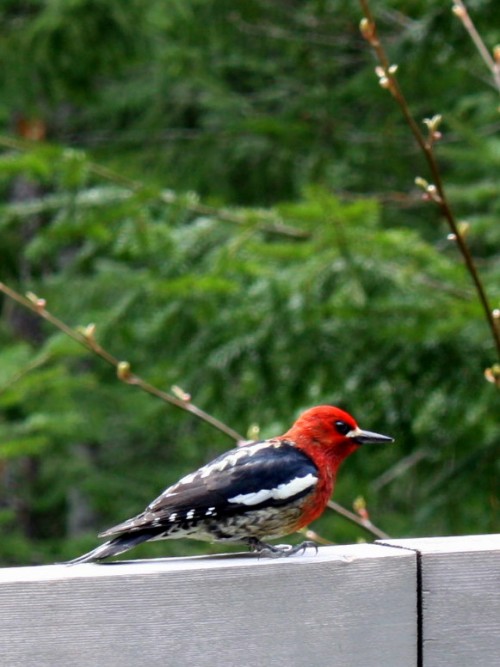
Great article!
I enjoyed reading this — thanks for sharing your bird journey. Makes me want to be more observant with the birds in my neighborhood.
“…the most inspiring form of naturalizing involves time outside with binoculars, nature journal and guide book in hand. It’s where the best discoveries are made.” Absolutely right! Great story Coli, and great photos Kate!
This is truly a great time of the year, especially for us naturalists and bird people, and your post here surely explains why. Very nicely done, and great photos! How wonderful to live where you can look up from your work at such a colorful member of the community!
I love this, Codi, and how fortunate you are to be embedded and serving in the Church of the Mother (nature)! Kate’s photos are beautiful and really help bring this story to life. I especially like the pictures of the sapsucker surveying followed by the methodical excavation; as well as your respectful nod to the practical use of technology but still returning to the in person observation for the really good stuff!! Great work…enjoy!
I love this article Cori, the behavior stuff reminds me of the observations I made with Libby last weekend! I hope many friends will sign up for the Spring Birding weekend with Libby Mills and Tim Manns June 3-5! I can promise that this will be terrific!